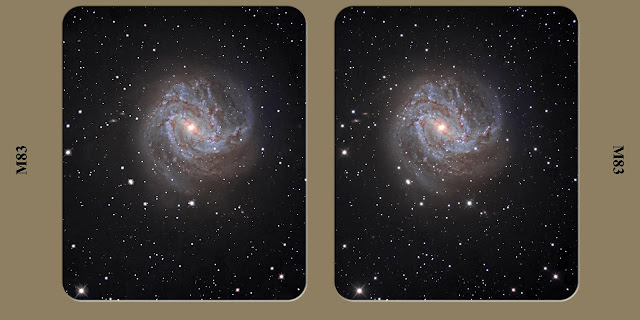COPYRIGHT, PLEASE NOTE
All the material on this website is copyrighted to J-P Metsavainio, if not otherwise stated. Any content on this website may not be reproduced without the author’s permission.
BUY A MUSEUM QUALITY POSTER
BUY A POSTER:https://astroanarchy.zenfolio.com/
Tuesday, June 1, 2010
M83, the "Southern Pinwheel" as a 3D stereo pair
Parallel vision
Cross vision
Other 3D-formats can be found here:
Original 2D-image:
NOTE! This is a personal vision about forms and shapes, based on some known facts and an artistic impression.
Viewing instructions can be found from a Right hand side menu.
Viewing instructions can be found from a Right hand side menu.
Labels:
stereo images
M83, the "Southern Pinwheel" as an anaglyph Red/Cyan 3D
You'll need Red/Cyan Eyeglasses to be able to see this image right. Note, if you have a Red and Blue filters, you can use them! Red goes to Left eye.
Other 3D-formats can be found here:
Original 2D-image:
NOTE! This is a personal vision about forms and shapes, based on some known facts and an artistic impression.
Labels:
anaglyph images and movies
Sunday, May 30, 2010
Astro anarchy gets published
NGC 6888 in HST-palette at National Geographic's "Daily Dozen"
May - Week 4
My image of the "crescent Nebula", NGC6888, was selected in a
"Daily Dozen" of National Geographic Magazine's webpage.
This was the selected image. Original post with details can be found HERE.
You can vote my image to be printed in National Geographic magazine.
Please, use this link to give a vote:
Labels:
publications
Saturday, May 29, 2010
M16 experiment, narrow band with a Broad band luminance.
HST-palette colors with a Broad band luminance. RGB-Stars.
Red=S-II, Green=H-a and Blue=O-III
Natural color narrow band composition with a Broad band luminance. RGB-Stars.
Red=70%Ha+30%S-II, Green=O-III and Blue=70%O-III+30%H-alpha.
In this experimental image, I have tested the method to use a clear filter luminance with a narrow band color. This is (only?*) scientifically correct method to use a luminance image with a narrow band colors, since a broad band luminance contains all the wave lengths used for color information.
I don't usually like to mix colors from a different imaging methods, like pure RGB and narrow band. In this case I have used RGB, real color, stars with an emission line image.
I don't usually like to mix colors from a different imaging methods, like pure RGB and narrow band. In this case I have used RGB, real color, stars with an emission line image.
Some astro imagers tend to use H-alpha channel as a luminance, due the higher details and better S/N than any other channel has. Even though the visual appearance might look better, other channels, O-III and S-II, has no information in H-a luminance and all details in there are lost!
(*I have to point out, I use H-a luminance with a many NB images but H-a is boosted with all the information in O-III and S-II channels used. I call this method "Tone Mapping". Step by step instructions can be found here: http://astroanarchy.blogspot.com/2009/04/neaic.html )
The original narrow band image, with technical details, of M16 can be found here:
http://astroanarchy.blogspot.com/2010/05/m16-eagle-nebula-in-hst-palette.html
Technical details
Imaged with a Northern Galactic members remote telescope in Australia, https://blogger.googleusercontent.com/img/b/R29vZ2xl/AVvXsEhT5xcPgdl42zGREyCwydFYagJMAi08LFbJBf0G3CN2kmyirDNtFbaj3xJ_bmA93X2t1nxBQX4uTWobfRYnYLT3TiqNZVZMbdW7hVlAVGWRYnTRndCGV9zhHmxvyEAHSz3sVHzVefaXEFg/s1600/NGTelescopeL.jpg
16" RCOS ja Apogee U9000 camera.
LRGB combo.
H-alpha 5x1200s, O-III 2x1200s, S-II 2x1200s . Dark and Flat calibrated.
Broad band luminance 15x300s.
RGB-colors Red 2x300s, Green 2x300s and Blue 2x300s.
Raw data is shared with Petri Kehusmaa and J-P Metsavainio
Processing workflow:
Image acquisition, MaxiDL v4.xxx
Stacked and calibrated in CCDStack.
Deconvolution with a CCDSharp, 30 iterations.
Deconvolution with a CCDSharp, 30 iterations.
Levels, curves and color combine in PS CS3.
Labels:
Narrowband color images,
nebula
Subscribe to:
Posts (Atom)















